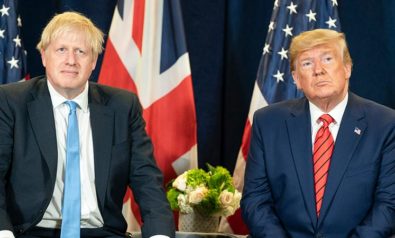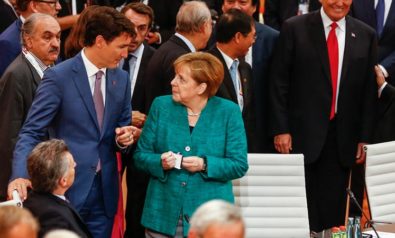Small and medium-sized enterprises (SMEs) are businesses with revenues, assets or employees below a certain threshold. SMEs are important to the health of any country as they tend to form the backbone of the economy. When compared to large enterprises, SMEs are generally greater in number, employ far more people, are often situated in clusters and typically entrepreneurial in nature. They drive local economic development, propel job creation and foster growth and innovation.
360° Context: How Will COVID-19 Impact Our Economy?
According to the World Bank, SMEs represent about 90% of businesses and 50% of employment worldwide. In the United States, 30 million small businesses make up 44% of GDP, 99% of the total businesses and 48% of the workforce, amounting to 57 million jobs. In India, the SME sector consists of about 63 million enterprises, contributing to 45% of manufacturing output and over 28% of GDP while employing 111 million people.
SMEs in China form the engine of the economy comprising 30 million entities, constituting 99.6% of enterprises and 80% of national employment. They also hold more than 70% of the country’s patents and account for more than 60% of GDP, contributing more than 50% of tax collections.
Different Countries Define SMEs Differently
Though most experts agree on the crucial role SMEs play in any economy, the definition of an SME varies by country. In the US, the Small Business Administration (SBA) defines SMEs broadly as those with fewer than 500 employees and $7 million in annual receipts, although specific definitions exist by business and sector. Annual receipts can range from $1 million for farms to $40 million for hospitals. Services businesses such as retail and construction are generally classified by annual receipts, while manufacturing and utilities are measured by headcount. In June, the Indian government revised its SME definitions, expanding the revenue caps on medium and small enterprises from $7 million and $1.5 million to $35 million and $7 million respectively. In the United Kingdom, a small business is defined as having less than 50 employees and turnover under £10 million ($12.7 million), whereas a medium business has less than 250 employees and turnover under £50 million.
Proper definitions matter. If SMEs are classified well, their access to capital and other resources can improve. They can apply for grants, get tax exemptions, collaborate on research with governments or universities or access other schemes. This gives SMEs better opportunities to survive and thrive.
Since SMEs tend to be the biggest employers in most economies, a good policy to promote them creates jobs and develops worker skills. Furthermore, proper definitions enable governments to focus their efforts regarding SMEs and level the playing field for them vis-a-vis large corporations.
Given the scale and nature of their business models, SMEs operate at the mercy of vagaries of the economy, geopolitical events and local policies. They battle competition from multinational giants, volatile cash flows, fickle customers, demanding suppliers and constantly churning employees. But the COVID-19 pandemic has crossed all boundaries. While the 2000 crisis was a dot-com bust and 2008 was a collapse of the financial systems, 2020 is clearly the SME crisis. It is Murphy’s Law at its extreme — anything that can go wrong has indeed gone wrong.
The coronavirus crisis started off in early 2020 as a supply shock, which has now turned into a demand shock, impacting customers, employees, markets and suppliers alike. The consequences can be potentially catastrophic with the International Monetary Fund estimating that SME shutdowns in G20 countries could surge from 4% pre-COVID to 12% post-COVID, with bankruptcy rates in the services sector increasing by more than 20%.
SMEs are bearing the brunt of the economic and financial fallout from the COVID-19 pandemic, not least because many were already in duress before the crisis. This could have a domino effect on the economy, given the pivotal role played by SMEs. Therefore, it comes as no surprise that most governments have sought to intercede legislatively with their fiscal might to ameliorate the predicament of SMEs.
Indian and American Response
It is instructive to note how different countries have responded to the economic crisis. India is a good country to start with. In early May, the government announced a 20-trillion-rupee ($250 billion) stimulus package called Atmanirbhar, equivalent to 10% of India’s GDP. It was a mixture of fiscal and monetary support, packed as credit guarantees and a slew of other measures. The centerpiece was an ambitious 3-trillion-rupee ($40 billion) initiative for SMEs, including instant collateral-free loans, subordinate debt of 200 billion rupees ($2.5 billion) for stressed micro, small and medium enterprises (MSMEs), and a 500-billion-rupee ($6.5 billion) equity infusion. Perhaps the largest component of the stimulus was the Emergency Credit Line Guarantee Scheme (ECLGS) that provides additional working capital and term loans of up to 20% of outstanding credit.
Although the scheme received positive feedback, the initial uptake was slow. On the supply front, bankers fretted about future delinquencies arising out of such accounts as the credit guarantees only covered incremental debt. On the demand side, SMEs were worried about taking on additional leverage when there is uncertainty about economic revival. Moreover, a 20% incremental loan may not suffice to service payrolls and operating expenses and keep business alive.
Also, while this scheme addressed existing borrowers, the fate of those who are not current borrowers is unclear. While initial traction for the scheme was low, the recent momentum has been encouraging. The finance ministry reports that as of July 15, banks have sanctioned 1.2 trillion rupees ($16 billion), of which 700 billion rupees ($9 billion) have been disbursed largely by public sector banks, although private sector banks have joined in lately.
Meanwhile, even the largest global economy has struggled with its SME relief program. In mid-March, US President Donald Trump approved a $2.2-trillion package under the Coronavirus Aid, Relief and Economic Security (CARES) Act to help Americans struggling amid the pandemic. One of the signature initiatives under the act was the $660-billion Paycheck Protection Program (PPP) aimed at helping small businesses with their payroll and operating expenses. This program was distinct from its peers in its loan forgiveness part, in which the repayment of the loan portion used to cover the first eight weeks of payroll, rent, utilities and mortgage would be waived.
The program, though well-intentioned, has struggled with execution issues exacerbated by labyrinthian rules. Matters came to a head when the initial tranche of $349 billion ran out in April. The program had to be refinanced but, by June, it was closed down with $130 billion of unused funds in its coffers. The program was restarted again and extended to August by Congress.
Worse, the program saw refunds from borrowers who were unclear about the utilization rules. Loan forgiveness would be valid only if the amount was utilized within eight weeks. This stipulation made SMEs wary because their goal was to use cash judiciously and optimize the use of the borrowed amount to last as long as possible. These rules have since been amended by the Small Business Administration. It now gives SMEs 24 weeks to use the borrowed funds and allows them more flexibility on the use of funds. In any case, questions have been raised about capital not reaching targeted businesses and unintended parties benefiting instead.
Despite the changes in SBA rules, the jury is still out on whether more SMEs will take out PPP loans. Some are lobbying for full loan forgiveness. However, dispensing of repayment requirements essentially creates handouts that could lead to the lowering of fiscal discipline and increasing incentive for fraud. A recent proposal by two professors, one from Princeton and the other from Stanford, suggests “evergreening” of existing debt, a practice that involves providing new loans to pay off previous ones. Though innovative, it is not quite clear how such a policy would provide better benefits compared to a loan repayment moratorium, especially when it comes to influencing future credit behavior.
In addition to the PPP program, the SBA has announced the Economic Injury Disaster Loans (EIDL) program. This offers SMEs working capital loans up to $2 million to help overcome their loss of revenue. The program was closed down on July 13 after granting $20 billion to 6 million SMEs. Maintaining equitability and efficacy in the distribution process has been a challenge, though.
European Responses
Europe’s largest economy, on the other hand, has fared relatively better. In early April, German Chancellor Angela Merkel announced a €1.1-trillion ($1.3 trillion) stimulus termed the “bazooka.” This constituted a €600-billion rescue program, including €500 billion worth of guarantees for loans to companies. The German state-owned bank KfW is taking care of the lending. The program also includes a cash injection of €50 billion for micro-enterprises and €2 billion in venture capital financing for startups, which no major economy has successfully managed to execute. Notably, the centerpiece of the German program is the announcement of unlimited government guarantees covering SME loans up to €800,000. These loans are instantly approved for profitable companies.
Berlin’s relief measures were specifically targeted at supporting Germany’s pride, the Mittelstand. This term refers to the 440,000 SMEs that form the backbone of the German economy. They employ 13 million people and account for 34% of GDP. Many of these firms manufacture highly-specialized products for niche markets, such as high-tech parts for health care and auto sectors, making them crucial to Germany’s success as an export giant. Not surprisingly, these companies have seen a contraction in revenues, especially the ones that depend on global supply chains.
The swift implementation of these initiatives, coupled with the resilience of the Mittelstand, is demonstrating that SMEs can survive and thrive in this environment. The Germans have also been preaching and practicing fiscal prudence in normal times, which has now worked in their favor. Germany can afford to inject capital and do whatever it takes to save its SMEs.
Since its first stimulus, Berlin has followed up with an additional €130-billion package consisting of tax, SME loans and spending measures aimed at stimulating demand. This included a €46-billion green stimulus focused on innovation and sustainable projects such as e-mobility and battery technology. In keeping with the German tradition, the SMEs who make the Mittelstand have stayed agile as well. They are diversifying their customer base and pivoting their business models to more recession-proof sectors.
The UK, another major world economy, also launched an array of relief measures, including the Coronavirus Business Interruption Loan Scheme (CBILS) worth £330 billion ($420 billion). This was designed to support British SMEs with cash for their payroll and operating expenditure. It also announced the Bounce Back Loan Scheme (BBLS) focused on smaller businesses. This enjoyed a better launch than CBILS because the latter, with its larger loan quantum, required more vetting and paperwork.
Loans from the CBILS initiative, although interest-free for a year, are only 80% guaranteed by the government. This makes banks less willing to lend during these troubled times because they are afraid of losing 20% of the loan amount. This slows credit outflow and starves SMEs of much-needed capital. As of July 15, less than 10% of the allotted capital had been utilized, which banks blame on an inadequately designed scheme. By mid-July, only £11.9 billion had been disbursed to 54,500 companies through the CBILS and £31.7 billion to 1 million smaller firms through the BBLS.
Businesses have sought modifications from policymakers to existing schemes. These include hiking government guarantees for loans to 100% and waiving personal guarantees for small loans. The Treasury has agreed to some of these demands. Critics also point to structural deficiencies in the system. They believe the administrative authority for SME loans should be a proper small business bank instead of the British Business Bank, which was not designed for SMEs. Already, the UK government has warned that £36 billion in COVID loans may default. More drastic measures seem to be on the way, including a COVID bad bank to house toxic SME assets.
Responses Elsewhere
Economies around the world have been responding to disruption by COVID-19. It is impossible to examine every response in this article, but Japan’s case deserves examination. The world’s third-largest economy had been battling a recession even before the pandemic. Declining consumption, falling tourism and plunging exports were increasing the pressure on an aging society with a spiraling debt of over $12.2 trillion. The pandemic has strained Japan’s fiscal health further.
In response to the pandemic, the Bank of Japan announced a 75-trillion-yen ($700 billion) package for financing SMEs, which included zero-interest unsecured loans. Additionally, the National Diet, Japan’s parliament, enacted a second supplementary budget, which featured rent payment support and expanded employment maintenance subsidies for SMEs.
The execution of these programs has been tardy. The government’s 2015 digitalization drive is still incomplete, impacting the distribution of subsidies and the implementation of other relief measures. Of the more than 400,000 applications for employment adjustment subsidies, only 80,000 companies received aid by mid-June. Application procedures are unnecessarily complex, adding to the woes of SMEs.
Any discussion on SMEs in the global economy would be incomplete without examining China, which was the first country to deal with the COVID-19 disease. In February, the government announced a 1.2-trillion-renminbi ($174 billion) monetary stimulus. Large state-owned banks were ordered to increase lending to SMEs by at least 30% in the first half of 2020. Three of these banks alone were supposed to lend 350 billion renminbi ($49.7 million) to small businesses at preferential rates. In addition, Beijing encouraged local policymakers to provide fiscal support to keep SMEs afloat.
China’s stimulus seems more understated compared to other major economies and their own 2008 bailout package. After controlling the first COVID-19 wave in March, the Chinese have focused on restarting the economy and reopening businesses instead of relief measures and bailouts.
In February, surveys in China showed that 30% of SMEs had experienced a 50% decline in revenue. Surveys also found that 60% of SMEs had only three months of cash left. At the end of March, almost half a million small businesses across China had closed and new business registrations fell by more than 30% compared to last year. The resumption of work has been an uphill struggle. In April, the production rate of SMEs had crossed 82% of capacity, but the sentiment had remained pessimistic. Notably, the Small and Medium Enterprise Index (SMEI) had risen from 51.7 in May to 53.3 in June, indicating that SMEs are slowly reviving.
With the easing of lockdown measures, domestic demand in China has picked up, driving SME sales. In turn, greater demand is increasing production activity and accelerating capacity utilization, causing a mild rise in hiring. The green shoots of recovery of Chinese SMEs should encourage authorities worldwide.
Policy Lessons for the Future
Governing nation-states is an arduous task at the best of times and especially so in a nightmarish year of dystopian proportions. No wonder governments worldwide have appeared underprepared to combat the COVID-19 crisis. Whilst predicting a global pandemic of this scale would be next to impossible, there were early warning signs that severe disruptions to global health care, supply chains and business models were imminent. Yet scenario planning and stress testing of economic models has been flawed, impacting the swift rollout of relief measures.
The crisis has also underlined the importance of fiscal discipline when economies are doing well. Countries that do so can build a robust balance sheet to leverage during troubled times. This crisis also brings home the importance of evaluating and reevaluating the efficacy of the entities that deal with SMEs. Policymaking is an iterative process, especially when it comes to SMEs and bodies that oversee them must be overhauled periodically.
Importantly, policies pertaining to SMEs must have inputs from those with domain expertise. Structures must take into account execution capabilities and speed of delivery. Instant loan approvals with suboptimal due diligence have to be constantly balanced against longer vetting but slower turnarounds. Similarly, policymakers have to analyze the various types of instruments, fiscal and monetary, that can be used for SMEs. What works in one country may not work for another.
It is important to remember the nuances of different policy measures, such as guarantees, forgiveness, monitoring and moratoriums. Guarantees are a sound instrument for relief but are potential claims on the government’s balance sheet and contingent liabilities. They also have little economic value if capital is not promptly delivered to SMEs. Forgiveness provisions have their own issues. They may be important in a crisis but could incentivize subpar credit behavior in the future. Similarly, monitoring is important but is impractical when millions of SMEs are involved. There is no way any authority can keep a tab on the intended usage of funds. Finally, moratoriums have their own problems. Businesses could misuse moratoriums, putting pressure on banks and making accounting difficult. They were cheered at the onset of the crisis but further extensions could be costly to the ecosystem.
Going forward, governments need to prepare for the long haul. The consequences of the COVID-19 pandemic will stay with us for the foreseeable future. What began as a liquidity crisis might well become a solvency crisis for SMEs despite the best attempts to avoid that eventuality. If that does happen, governments will need to plan for efficient debt restructuring. They will have to institute insolvency management processes while figuring out how to handle bad asset pools. In simple language, governments will have to make tough decisions as to distributing gains and losses not only among those living but also future generations.
The views expressed in this article are the author’s own and do not necessarily reflect Fair Observer’s editorial policy.
Support Fair Observer
We rely on your support for our independence, diversity and quality.
For more than 10 years, Fair Observer has been free, fair and independent. No billionaire owns us, no advertisers control us. We are a reader-supported nonprofit. Unlike many other publications, we keep our content free for readers regardless of where they live or whether they can afford to pay. We have no paywalls and no ads.
In the post-truth era of fake news, echo chambers and filter bubbles, we publish a plurality of perspectives from around the world. Anyone can publish with us, but everyone goes through a rigorous editorial process. So, you get fact-checked, well-reasoned content instead of noise.
We publish 2,500+ voices from 90+ countries. We also conduct education and training programs
on subjects ranging from digital media and journalism to writing and critical thinking. This
doesn’t come cheap. Servers, editors, trainers and web developers cost
money.
Please consider supporting us on a regular basis as a recurring donor or a
sustaining member.
Will you support FO’s journalism?
We rely on your support for our independence, diversity and quality.
































